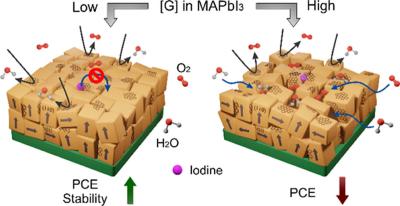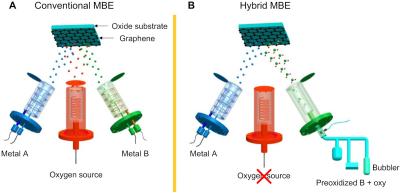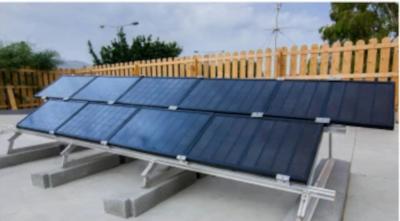Perovskites are materials that share a crystal structure similar to the mineral called perovskite, which consists of calcium titanium oxide (CaTiO3).
Depending on which atoms/molecules are used in the structure, perovskites can possess an impressive array of interesting properties including superconductivity, ferroelectricity, charge ordering, spin dependent transport and much more. Perovskites therefore hold exciting opportunities for physicists, chemists and material scientists.
Graphene is a one-atom-thick layer of carbon atoms arranged in a hexagonal lattice. It is the building-block of Graphite (which is used, among others things, in pencil tips), but graphene is a remarkable substance on its own - with a multitude of astonishing properties which repeatedly earn it the title “wonder material”. Graphene is the thinnest material known to man at one atom thick, and also incredibly strong - about 200 times stronger than steel. On top of that, graphene is an excellent conductor of heat and electricity and has interesting light absorption abilities. These varied properties make it a promising and highly researched material, with hopes of incorporating it in many applications: from inks and composite materials, through sensors, solar cells and water filters, to batteries and supercapacitors.
Due to their unique properties, carbon-based nanomaterials have been the center of extensive research efforts in various fields, one of which is the field of photovoltaic energy conversion. In recent years, hybrid metalorganic halide perovskites have become one of the most promising materials for third generation solar cells, with efficiencies that are constantly on the rise.
The incorporation of graphene into perovskite-based solar cells was naturally proposed, and significant work is taking place on this matter. Graphene-based perovskite solar cells are studied in many ways, including hole and electron transport media (HTM and ETM), electrodes, and various approaches aiming at improving the stability of the device. Tandem architectures based on graphene interlayers are also of great interest.
In addition to solar cells, other areas of graphene and perovskite integration include sensors and photodetectors, QDs, nanocatalysts and more.
Researchers design efficient carbon-based perovskite solar cells with phosphorene HTL
Researchers from Australia's Griffith University and Queensland University of Technology have reported the fabrication of planar carbon-based perovskite solar cells (c-PSCs) with high efficiency and excellent stability, by employing electrochemically produced large-area phosphorene flakes as a hole-transporting layer (HTL).
Carbon-based perovskite solar cells have attracted increasing attention due to their many advantages, including: ease of fabrication, the potential of assembling flexible devices, low manufacturing costs and more. However, c-PSCs suffer from limited hole extraction and high charge carrier recombination due to inadequate interface contact between the carbon electrode and perovskite film.
Researchers examine a perovskite-graphene device for X-ray detection
Researchers at Graphenea, University of Utah and Kairos Sensors have examined a perovskite-based graphene field effect transistor (P-GFET) device for X-ray detection.
The device architecture consisted of a commercially available GFET-S20 chip, produced by Graphenea, with a layer of methylammonium lead iodide (MAPbI3) perovskite spin coated onto the top of it. This device was exposed to the field of a molybdenum target X-ray tube with beam settings between 20 and 60 kVp (X-ray tube voltage) and 30–300 μA (X-ray tube current). Dose measurements were taken with an ion-chamber and thermo-luminescent dosimeters and used to determine the sensitivity of the device as a function of the X-ray tube voltage and current, as well as source-drain voltage.
Researchers report perovskite nanowires-based graphene plasmonic waveguides with low loss and low gain threshold
Researchers at China's Huanghe Science and Technology University, Zhengzhou Normal University and Zhongke Weike Technology (Henan) Co., Ltd have designed a perovskite nanowire-based graphene plasmonic waveguide, where the perovskite nanowire is located on the graphene-insulator-metal (GIM) platform. The findings of this work could have potential applications in plasmonic waveguide-based devices, such as lasers, modulators, sensors, etc.
The finite element method was used in order to investigate the impact of the perovskite nanowire radius, graphene layer thickness, Fermi energy level of the graphene, thickness of the low index dielectric layer, and permittivity of dielectric layer on the mode properties. The results indicate that the hybrid mode exhibits very low propagating loss and ultra-high figure of merit.
First Graphene, Halocell and QUT secure funding for perovskite PV project
Graphitic materials supplier First Graphene has announced an R&D collaboration with Greatcell Energy, trading as Halocell Energy, and the Queensland University of Technology (QUT) to commercialize perovskite solar cell fabrication. The project has received a Cooperative Research Centers Project (CRC-P) grant worth over AUD$2 million (around $USD1,300,000).
The research and development project is intended to commercialize ultra-low-cost, flexible perovskite solar cell fabrication using Halocell’s roll-to-roll production process at the company’s Wagga Wagga plant, First Graphene said in an announcement. Through the project, First Graphene plans to develop cost-effective graphene-based electrode replacements for high-cost conductor materials, such as gold and silver, used in cell manufacturing.
Greatcell Australia and First Graphene explore graphene enhancements to perovskite solar cells
It was recently reported that Greatcell Australia is working with graphene company First Graphene on graphene enhancements to perovskite solar cell technology.
Greatcell Australia has reportedly established a pilot plant in New South Wales and is in the advanced stages of testing its range of perovskite solar cells (PSCs) with manufacturers around the world. “Greatcell is aiming to modularize their production lines for product flexibility, due in part to the easier assembly and reduced number of steps to produce PSCs compared to silicon solar cells.”
Researchers present new method for fabricating thin films of perovskite oxide semiconductors
Researchers from the University of Minnesota Twin Cities-led, University of Wisconsin–Madison and Pacific Northwest National Laboratory have developed a new method for making thin films of perovskite oxide semiconductors, a class of “smart” materials with unique properties that can change in response to stimuli like light, magnetic fields, or electric fields.
Their work could allow researchers to harness these properties and even combine them with other emerging nano-scale materials to make better devices such as sensors, smart textiles, and flexible electronics.
Researchers examine how molybdenum ditelluride could increase carrier generation in perovskite solar cells
Researchers from South Korea's Sungkyunkwan University (SKKU) have found that molybdenum ditelluride could increase carrier generation in perovskite solar cells.
They simulated a tandem solar cell with two absorbers based on methylammonium lead triiodide (CH3NH3PbI3) – a perovskite with high photoluminescence quantum yield – and molybdenum ditelluride (MoTe2), which is known for being naturally p-doped, with cascaded bandgaps to absorb a wider solar spectrum. The team determined that its efficiency could exceed 20%.
Researchers design graphene oxide/silicon heterojunction solar cell with 18.8% efficiency
Researchers from Hebei University, Karlsruhe Institute of Technology and Chinese module manufacturer Yingli Green Energy Holding Co. Ltd. have reported a heterojunction solar cell based on graphene-oxide (GO) and silicon with a large area of 5.5 cm2.
GO is a compound of carbon, oxygen and hydrogen that is obtained by treating graphite with oxidizers and acids. It consists of a single-layer sheet of graphite oxide that is commonly used to produce graphene-related nanomaterials for various applications, including electronics, optics, chemistry and more. The scientists developed an ink made of GO mixed with Nafion, that can be spin-coated on an n-type silicon wafer to form a high-quality passivating contact scheme. “Low interface recombination is provided by the Nafion and carrier selection by the GO,” the team explained, noting that the passivation scheme also includes an electron-selective passivation contact comprising n-doped hydrogenated amorphous silicon with an indium tin oxide (ITO) overlayer aimed at improving light trapping and reducing surface recombination.
Researchers integrate large-area graphene-perovskite solar panels into stand-alone solar farm
An international research group, including teams from CHOSE at the University of Rome Tor Vergata, Hellenic Mediterranean University in Greece and others, has developed a large-area perovskite solar panel with graphene-doped electron transporting layers (ETLs) and functionalized molybdenum disulfide (fMoS2) buffer layers inserted between the perovskite layer and the hole transporting layer (HTL).
The team reported that with increasing temperatures, the module exhibited a smaller drop in open-circuit voltage than commercially available crystalline silicon panels.
Researchers demonstrate how graphene can improve perovskite solar cells
Recent research has shown that the incorporation of graphene-related materials improves the performance and stability of perovskite solar cells. Graphene is hydrophobic, which can enhance several properties of perovskite solar cells. Firstly, it can enhance stability and the passivation of electron traps at the perovskite's crystalline domain interfaces. Graphene can also provide better energy level alignment, leading to more efficient devices.

In a recent study, Spain-based scientists used pristine graphene to improve the properties of MAPbI3, a popular perovskite material. Pristine graphene was combined with the metal halide perovskite to form the active layer of the solar cells. By analyzing the resulting graphene/perovskite material, it was observed that an average efficiency value of 15% under high-stress conditions was achieved when the optimal amount of graphene was used.
Pagination
- Page 1
- Next page







